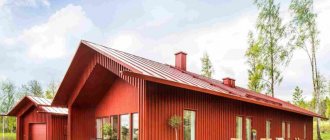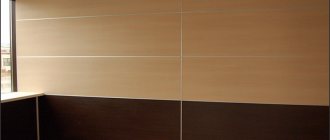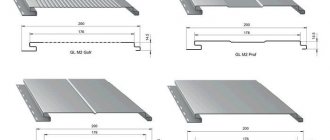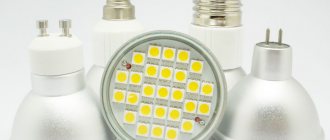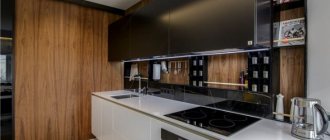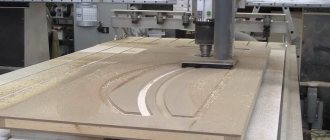What is LED
An LED is a semiconductor element that transforms the resulting electric current into direct light radiation. In English it sounds like this, light emitting diode, or LED. This is where the name LED light bulbs, which are popular nowadays, comes from. How this semiconductor mechanism works is not the subject of our article. It's quite difficult. Let us only add that lighting depends on the current power, but it has a limit that cannot be violated.
LEDs have one serious drawback - price. After all, the price of a unit of light (lumen) for an LED lamp is tens of times higher than the price for a halogen unit. But technology does not stand still and in 2-3 years the situation will change, LED lamps will become cheaper by ten times.
It should also be noted that LEDs are durable, most of them last up to 100,000 hours. But just don’t overload them.
What are light panels
The principle of LEDs has been translated into new ultra-thin light panels, which are installed on the ceiling of public buildings and large areas where a high luminous flux is required. Of course, it is possible to use such panels in domestic conditions, especially since they come in such a variety of shapes:
Types of LED panels
As you can see from the pictures, the shapes of LED panels can be different:
- square (200 – 600 mm);
- round (diameter up to 250 mm);
- rectangular (from 200 – 1200 mm).
The service life of LED panels is up to 50,000 hours.
LED panels can be mounted mainly with the following types of mounts :
- embedded, when a panel is built into a ceiling or wall into an opening previously prepared to size, this can be an Armstrong-type ceiling. In this option, it is necessary to strengthen the edges with a metal profile;
- overhead, when attached to hardware to the ceiling;
- suspended, when it is suspended on cables to illuminate a certain space, for example, above a dining table. In such cases, most likely it will be a basic ceiling, i.e., consisting of a floor panel and plaster, and it will be mounted on a cable suspension with the ability to adjust the height level.
Selection and installation of electrical wiring
When the panels are selected, one of the most crucial moments comes - installation of electrical wiring . To organize power supply for standard LED panels, any double-insulated electrical wire is suitable, which must be brought from the switch to the place where the panel is fixed on the ceiling and connected to the device.
In this case, one main wire with branches can simultaneously power several devices. The main thing is to calculate the total power consumption, which should be just below the throughput of the electrical wire.
What does an LED panel consist of?
- The panel body is made of aluminum alloy, which, like any metal, has high thermal conductivity. It also serves as a heat dissipation element for the LED. If the LED heats up, its working life is proportionally reduced.
- LEDs are located around the perimeter of the housing frame. As mentioned above, the lamp body acts as a radiator, i.e. it removes temperature from the LED, so overheating is excluded. LEDs emit light.
- Internal diffuser made of organic glass, which allows you to create uniform soft light throughout the panel.
- The reflective film is located behind the lens and redistributes the flux emitted by the LEDs perpendicularly downwards.
- A light-conducting lens with laser notches creates a matte dispersion and does not create a strain on vision, and does not cause eye fatigue, since there is no flickering of light sources. This light allows you to maintain concentration and attention.
Advantages of LED panels
All panels have a correctly calculated light balance, which prevents them from overheating. This is an important property of LEDs, since overheating reduces the luminous flux and its power. But there is also a plus, even if one of the LEDs fails, the rest will work, but at a lower intensity. If an LED fails, the service life of the panel as a whole is reduced. But that's okay, it can simply be replaced.
The body from which the panel is made is made of aluminum alloy and no more than 10 mm thick. This design easily fits into a suspended ceiling, without requiring additional space for hanging suspended ceilings in height. This is a definite plus for limited ceiling spaces. Also, visually, such lighting increases the volume of the room. If we compare LED lamps with raster fluorescent lamps, their thickness reaches 100 mm, which is 10 times more than a light panel.
All LED panels are supplied complete with a stabilized power supply with an operating range from 110 to 240 W.
The reliability of the electrical safety of the entire electrical system is ensured through a power source that has built-in short circuit protection.
All LED panels are ultra-light and ultra-thin and have their own spring fastening system, which securely fixes it in the ceiling structure. They can easily fit in place of raster fluorescent lamps, for example, in the Armstrong ceiling system.
LED panels do not emit ultraviolet and infrared radiation. This property is important where it is necessary to ensure the preservation of the light of illuminated objects.
Another important quality of such panels is that they do not contain heavy metals and mercury and this certainly does not require special disposal; simple plastic and aluminum are easily disassembled and recycled.
LED panels can also be used in high-tech home interiors.
Kitchen in High-Tech style
LED panels in bedroom decoration.
LED panels in the living room
There are designers who manage to fit such lamps into the walls, look how organic they look.
Living room design
Bedroom in high-tech style
Decorating a hotel room
In addition to their size, the panels also differ in light saturation. They are divided into warm, cold and neutral radiated fluxes.
Design features and advantages of lamps of this type
The LED panel includes the following main components:
- Metal or plastic case.
- LED lamps or strip placed around the perimeter.
- Internal reflector.
- Glass lens for transforming and setting the direction of the light flux.
- External diffuser in the form of a plate or film.
- Back cover.
- Elements for installation.
In addition, in the internal space of the panel, depending on the model, a converter and driver that controls the operation of the LED lamp may be located. The image below shows the schematic structure of such a device:
Based on the method of fastening and, accordingly, external design, LED panels are divided into three main types:
- Hanging.
- Invoices.
- Built-in.
In this case, standard light panels are made in the shape of a square. However, there are also round and rectangular modifications. The power of the product and the number of LEDs directly depends on its geometric dimensions. The strongest and largest models are found among rectangular devices, with a large side up to 1200 mm.
LED panels, in comparison with lampshades and chandeliers, have the following number of advantages:
- Economical energy consumption.
- Uniform illumination without signs of pulsation.
- Small thickness (7-24 mm).
- Long service life (up to 100 thousand hours).
- Higher luminous flux intensity at the same power.
- Operation at different temperature conditions.
- Standard installation procedures.
- Applicability for general, additional and zonal lighting.
- Possibility of design.
- Quiet operation.
- Elimination of IR and UV components of the radiation spectrum.
Despite the wide possibilities that LED panels provide, their purchase, installation and subsequent operation still has some disadvantages:
- High price.
- The need to use a step-down transformer and driver for power supply.
- Impossibility of combination with any interior.
Note! For commercial organizations, public premises, as well as houses and apartments decorated in a modern style and using expensive finishing, ice panels are better suited than other LED or standard lamps. In the long term, their installation is fully justified as durable, high-quality lighting devices that do not require repairs or maintenance.
Installation of LED panels for suspended ceilings
The panels can be installed in two versions - in a stretched PVC ceiling and in pre-tensioned installation. It is best to carry out installation before installing the ceiling. In this case, it is possible to securely and confidently fasten the embedded parts. Such parts are made of wood, for example, a 50 mm x 50 mm beam, or plywood trimmings of the required thickness are placed.
Installation procedure before installing the ceiling.
- A contour for the LED panel is cut out of plywood so that the places where the self-tapping screws are attached to the lamp fall on the wooden frame. The tree is attached using plumbs from plasterboard profile structures to the ceiling to the required level of PVC tension film.
- After installing the stretch ceiling, measurements are taken in the places where the mortgages are installed and a piece of fabric is cut out for the lamp. The edge of the fabric must be tightly glued along the entire contour to the wooden embedded part with moment-type glue. This is an important point and should not be taken lightly. Inattentive sizing can lead to tearing of the fabric.
- The LED panel is installed using a spring fastening system in its proper place.
The second option for installing panels with a stretched ceiling.
In this case, it is necessary to construct an embedded part structure like this.
- The panel is installed and the position of the plastic ring is measured.
- The fabric inside is cut out with a remainder of 20 mm and glued to the protruding plastic ring.
- Then the ring is wrapped inward and an LED chandelier is screwed to the embedded part.
Installation of LED panels in a suspended ceiling
If we have figured out the suspended ceiling, then it’s worth talking about the Armstrong-type ceiling. Installing such a system into the ceiling is quite simple. So, in the panels you need to mark the panels and cut a hole to size. Next, the LED panels are mounted in the opening using already known spring systems. The installation is complete.
In Armstrong-type ceilings, as we have already mentioned, the panels are built into the openings of the stiffening ribs of the ceiling system, because they can be selected to fit the size, for example, 600 mm x 600 mm.
Installation of the ceiling panel. LED ceiling panel daisy chain connection diagram.
Every day the market of modern electrical engineering is replenished with new, more advanced and practical models of lighting devices, which, unlike outdated traditional devices, have many unique characteristics that make their use much more profitable.
An exception are LED ceiling panels, which are not only efficient in operation, but also so easy to install that you can cope with this task yourself.
The daisy chain connection diagram for an LED ceiling panel is quite simple, however, even before starting installation work, it is worth paying more attention to such preliminary steps as choosing a specific panel model and its installation location. It would also be a good idea to study the main advantages and disadvantages of these modern high-tech devices.

